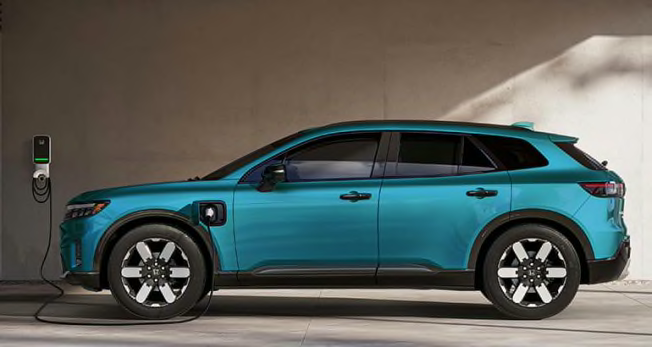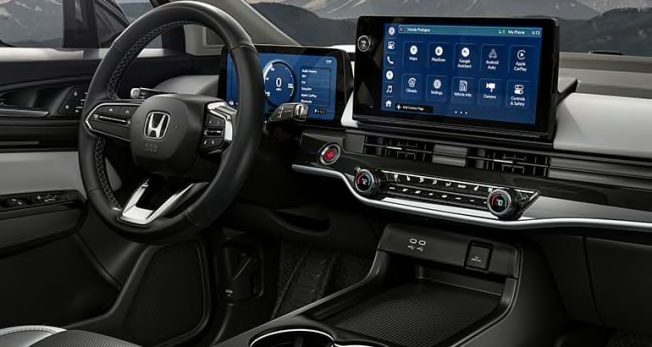Preview: 2024 Honda Prologue Electric Vehicle Is Sensible and Roomy
The new two-row SUV features single- and dual-motor drivetrains with almost 300 miles of range and a full complement of active safety equipment

The all-electric 2024 Honda Prologue SUV uses the same basic platform as the 2024 Acura ZDX and is the Honda brand’s first U.S. battery-electric model. It’s based on the General Motors Ultium electric vehicle platform as part of a partnership between Honda and GM.
- Honda Prologue: CR's Take Outside Inside What Drives It Active Safety and Driver Assistance
Honda is trailing nearly every other automaker in offering an electric vehicle. In 2022 the company announced that it would build the electric Prologue as part of a joint effort with General Motors, and it previously revealed the luxury version of the EV, the Acura ZDX. Both of these models jump ahead of the EVs from rival Toyota—the Toyota bZ4X and Lexus RZ—by offering a range near 300 miles.
CR's Take
The Honda Prologue is a result of the Honda-General Motors accord, which allows Honda to make use of GM’s Ultium batteries and the basic building blocks of GM’s electric vehicle architecture in designing and building the Prologue and ZDX. The Prologue is built in Mexico, alongside the Chevrolet Blazer EV. All leased Prologue’s qualify for tax incentives, and all purchased Prologues that have build date after Feb. 26, 2024.
This “fast” way into producing an EV should benefit Honda, given GM’s extensive experience building EVs like the Chevrolet Bolt and Bolt EUV, as well as plug-in hybrid electric vehicles (PHEVs) such as the Chevrolet Volt. Honda doesn’t have to start from scratch on its own platform, yet it also will launch a vehicle that promises generous range, unlike the Lexus RZ/Toyota bZ4X/Subaru Solterra joint effort.
This arrangement with GM is a prelude to Honda’s future plans to deliver EVs based on its own proprietary electric platform, called Honda e:Architecture, starting in 2026.
We bought a Prologue in late May. We will publish a first drive review on it in June, 2024.
Outside
Unlike the ZDX, the Prologue’s exterior styling is a tad more restrained while remaining in line with recent models such as the CR-V and Pilot SUVs. Honda says that the EV will be positioned alongside the two-row Passport in the brand’s SUV lineup.
The EV makes itself known with a large Honda “H” badge sitting on a solid “grille” that’s bracketed by wide LED headlights and DRLs on either side. The look is closer to an evolution of the current CR-V than either the Passport or three-row Pilot SUVs, with a large mesh opening below the bumper and vertically placed lights at the extreme edges of the front fascia.
The big fender arches house 19-inch wheels and 255/60R19 tires on the EX and Touring trims, while the top-level Elite trim will come with 21-inch wheels and 275/45R21 tires. A large charge port door sits just past the front fender on the driver’s side, in front of the driver’s door (shown below).

Like the Acura version, the Prologue has a long wheelbase, which allows for big front doors. Rear passengers have similarly large doors with a minimal cutout for the rear-wheel arch, hopefully meaning there’s a wide pathway for passengers to climb in.
The Prologue doesn’t appear to be offered with the ZDX’s contrasting black roof pillars, which gives the roof the appearance of floating above the rest of the body.
While the Prologue has a cab-rearward design, with the roof mildly sloping back to the top of the liftgate, it has more upright styling than the ZDX.
In the rear, the visual treatment is similar to the Pilot’s but still very distinctive. The LED taillights echo the DRLs upfront, as horizontal bars stretch from the rear fenders across nearly one-third of the liftgate. The Honda name sits prominently above the license plate cutout, with various model and trim badges affixed to the left and right edges of the tailgate.
Inside
Both the Prologue and ZDX have interior styling that’s influenced by the partnership with GM. For example, the steering wheel is directly from the Chevrolet Blazer and Equinox EVs, the Qi charging pad is the same one used in those GM vehicles, and the directional and windshield-wiper stalks on the steering wheel also come from the GM parts bin.
Behind the multifunction steering wheel is an 11-inch digital driver instrument screen with key gauges and information. Unlike the ZDX, the Prologue just uses a screen without a binnacle covering it. The center infotainment touchscreen measures 11.3 inches and features a Google-based operating system that can project Google Maps on either screen, which can be helpful particularly when navigating to a charging location. In addition, the system can estimate the charging time required to reach a destination and precondition the EV battery when a DC fast charging station is programmed as the destination. Wireless connectivity for Android Auto and Apple CarPlay is standard as well. GM, on the other hand, has announced that it will be dropping Apple CarPlay support in the future.
The interior’s Honda elements include the red ignition button and horizontal vent and dash motif found in the Civic, CR-V, and other recent Honda redesigns. The dashboard and center console are streamlined and uncluttered, with two large cup holders between the seats and a Qi wireless charger slot positioned aft, just in front of the center armrest and storage bin. The front of the console has two USB-C charging ports, and there are two more USB-C ports for rear-seat passengers. A large storage cutout can be seen under the center console for smaller items.

Photo: Honda Photo: Honda
Contrasting stitching appears on the armrests, steering wheel, and dashboard of the gray and black two-tone interior of the Elite trim, with shiny black surfaces sprinkled throughout. Heated front seats are standard on all trim levels. Overall, the photos of the Elite trim interior show a typical cabin for a top-level Honda: refined and attractive but not approaching luxury, which is reserved for the Acura line.
Both the Touring and Elite trims get a 12-speaker Bose sound system as standard equipment.
The automaker says that the EX features 25.2 cubic feet of storage room behind the raised second-row seats. Folding the 60/40-split seatbacks expands that space to 57.7 cubic feet, with an additional 0.5 cubic feet of space beneath the cargo floor.

What Drives It
Both front- and all-wheel-drive Prologues will be available. The FWD EX and Touring trims will have a single electric motor driving the front wheels with 212 hp, powered by an 85-kilowatt-hour lithium-ion battery pack.
All-wheel-drive models have a second electric motor mounted at the rear wheels. It, too, uses the 85-kWh battery, and the two motors combine to make 288 hp and 333 lb.-ft. of torque. This setup is optional on the EX and Touring, and standard on the Elite trim.
The single-motor EX trim has a driving range of 296 miles. That’s close to the Tesla Model Y Long Range AWD’s EPA rating of 330 miles per charge. How those models truly compare depends on how conservative or optimistic the automakers are with their figures, and we will evaluate Honda’s claims as soon as we purchase a Prologue of our own.
The automaker says that it can charge at speeds up to 155 kW at public DC fast chargers and can gain 65 miles of range in about 10 minutes. All of these figures are less than the ones released for the rear-wheel-drive Acura ZDX A-Spec and less than the Chevrolet Blazer EV.
Honda’s smartphone app will allow users to find, connect to, and pay for charging at existing and supported DC fast-charge networks. Honda has also joined with other manufacturers in announcing plans to build out a high-speed brand-neutral charging network in the U.S. and Canada in 2024. The goal of this consortium is to have at least 30,000 high-powered (350 kW+) charge points at 1,350 charging stations by 2030.
In addition, Prologue buyers get to choose among three available charging packages:
• Home Charging Station (11.5 kW) and $100 Public Charging Credit, plus a $500 Installation Incentive
• Portable Charging Kit (7.6 kW) and $300 Public Charging Credit, plus a $250 Installation Incentive
• $750 Public Charging Credit

Active Safety and Driver Assistance
The 2024 Honda Prologue comes standard with the Honda Sensing suite of active safety and driver assistance systems, which include automatic emergency braking (AEB) with pedestrian detection, AEB that works at highway speeds, blind spot warning, rear cross-traffic warning, rear cross-traffic braking, blind spot steering assistance, and rear pedestrian alert systems.
Buyers can choose to add optional self-sealing tires if they wish.





















